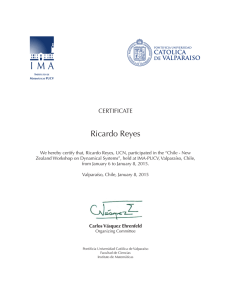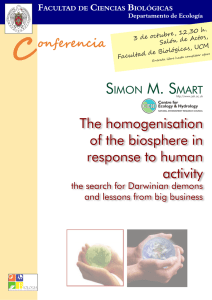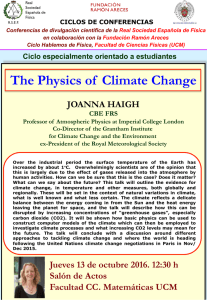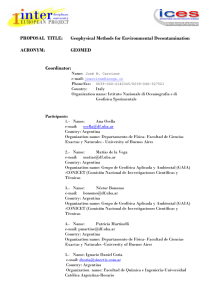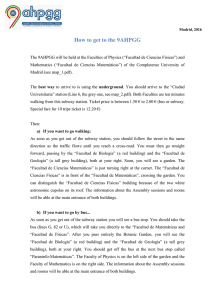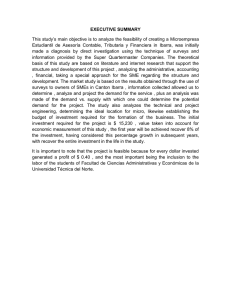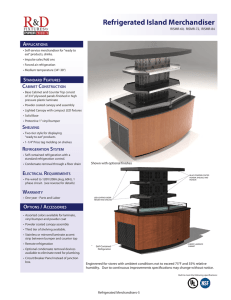Full Text - Avocadosource.com
Anuncio
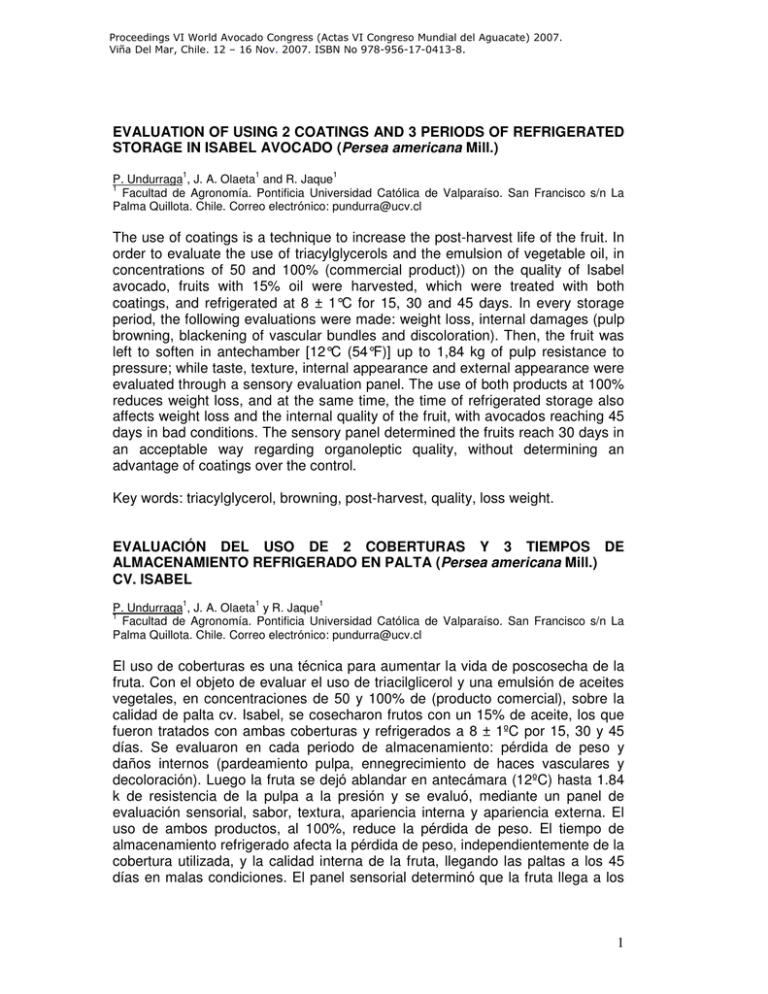
Proceedings VI World Avocado Congress (Actas VI Congreso Mundial del Aguacate) 2007. Viña Del Mar, Chile. 12 – 16 Nov. 2007. ISBN No 978-956-17-0413-8. EVALUATION OF USING 2 COATINGS AND 3 PERIODS OF REFRIGERATED STORAGE IN ISABEL AVOCADO (Persea americana Mill.) P. Undurraga1, J. A. Olaeta1 and R. Jaque1 Facultad de Agronomía. Pontificia Universidad Católica de Valparaíso. San Francisco s/n La Palma Quillota. Chile. Correo electrónico: [email protected] 1 The use of coatings is a technique to increase the post-harvest life of the fruit. In order to evaluate the use of triacylglycerols and the emulsion of vegetable oil, in concentrations of 50 and 100% (commercial product)) on the quality of Isabel avocado, fruits with 15% oil were harvested, which were treated with both coatings, and refrigerated at 8 ± 1°C for 15, 30 and 45 days. In every storage period, the following evaluations were made: weight loss, internal damages (pulp browning, blackening of vascular bundles and discoloration). Then, the fruit was left to soften in antechamber [12°C (54°F)] up to 1,84 kg of pulp resistance to pressure; while taste, texture, internal appearance and external appearance were evaluated through a sensory evaluation panel. The use of both products at 100% reduces weight loss, and at the same time, the time of refrigerated storage also affects weight loss and the internal quality of the fruit, with avocados reaching 45 days in bad conditions. The sensory panel determined the fruits reach 30 days in an acceptable way regarding organoleptic quality, without determining an advantage of coatings over the control. Key words: triacylglycerol, browning, post-harvest, quality, loss weight. EVALUACIÓN DEL USO DE 2 COBERTURAS Y 3 TIEMPOS DE ALMACENAMIENTO REFRIGERADO EN PALTA (Persea americana Mill.) CV. ISABEL 1 1 1 P. Undurraga , J. A. Olaeta y R. Jaque Facultad de Agronomía. Pontificia Universidad Católica de Valparaíso. San Francisco s/n La Palma Quillota. Chile. Correo electrónico: [email protected] 1 El uso de coberturas es una técnica para aumentar la vida de poscosecha de la fruta. Con el objeto de evaluar el uso de triacilglicerol y una emulsión de aceites vegetales, en concentraciones de 50 y 100% de (producto comercial), sobre la calidad de palta cv. Isabel, se cosecharon frutos con un 15% de aceite, los que fueron tratados con ambas coberturas y refrigerados a 8 ± 1ºC por 15, 30 y 45 días. Se evaluaron en cada periodo de almacenamiento: pérdida de peso y daños internos (pardeamiento pulpa, ennegrecimiento de haces vasculares y decoloración). Luego la fruta se dejó ablandar en antecámara (12ºC) hasta 1.84 k de resistencia de la pulpa a la presión y se evaluó, mediante un panel de evaluación sensorial, sabor, textura, apariencia interna y apariencia externa. El uso de ambos productos, al 100%, reduce la pérdida de peso. El tiempo de almacenamiento refrigerado afecta la pérdida de peso, independientemente de la cobertura utilizada, y la calidad interna de la fruta, llegando las paltas a los 45 días en malas condiciones. El panel sensorial determinó que la fruta llega a los 1 30 días de forma aceptable en cuanto a calidad organoléptica, sin determinar una ventaja de las coberturas sobre el testigo. Palabras clave: triacilglicerol, pardeamiento, poscosecha, calidad, pérdida de peso. 1. Introduction As of the year 1991, the Faculty of Agricultural Sciences of the Pontificia Universidad Católica de Valparaíso has been studying a new cultivar named Isabel, which has characteristics that concern the consumer and the producer, for a purple black colour when reaching maturity and for having greater resistance to cold temperatures (Zúñiga, 1998). Since it is a new cultivar, it is necessary to obtain all the information possible from all the aspects of the crop, of both pre-harvest and post-harvest. For Isabel cultivar, Garcia 2002 and Bontá 2006, determined 15% oil to develop good conditions of taste, while the best temperature of storage is 8±1ºC (46.4±33.8°F). Under these conditions the fruit does not develop injuries caused by cold temperatures and achieves 25-day storage. Other technique used to extend the post-harvest life of the fruit is the use of coatings, which delay the softening and improve the external appearance of the fruit. The coating produces a change in the gaseous exchange, which causes less loss weight. However, it could generate unwanted effects such as changes in colour and strange tastes. In Eureka lemons, Villarroel (2005) determined that the triacylglycerols prevent the water loss, by presenting weight losses below 7% of the weight. In Hass cultivar, the fruits treated with triacylglycerols showed a positive effect on the delay in the evolution of the skin colour. In addition, a sensory analysis determined a greater preference for treated fruit when the controls showed an excessive softening (Brito, 2005). In tomato, the use of triacylglycerol allows keeping humidity better by increasing the coating concentration (Coeffe, 2000). Nevertheless, in cherimoyas it was less effective in the control of loss weight (Pardo, 2001). Jeong, Huber and Sargent (2002) indicate that coatings not only reduce the loss of water and firmness of the pulp but also would not have an effect on the level of ethylene or the respiratory pattern. 2 The present work determined the effect of triacylglycerol-based coatings and vegetable oil emulsion on fruits of Isabel cultivar in three periods of refrigerated storage at 8 ± 1ºC. 2. Materials and methods Fruits of Isabel avocado were obtained at the Experimental Station La Palma of the Faculty of Agricultural Sciences, Pontificia Universidad Católica de Valparaíso, located in the city of Quillota (Latitude 32° 49’ S, Longitude 71° 16’W). Four trees of the Isabel cultivar grafted on Mexícola rootstock were marked. From each tree, 60 fruits between 200 and 350 g were collected, during October 2005, with maturity stage of 15-17% of oil. The fruits were taken to laboratory divided into 5 groups of 48, which were treated, respectively, with triacylglycerol (Ecofrut ®) in concentrations of 50 and 100% (commercial product), a vegetable-oil emulsion (Primafresh 50-V ®) in concentrations of 50 and 100% (commercial product) and keeping a non-treated control. The application of coatings was carried out with a brush, making sure to remove the excess of product applied; then the fruit was placed in filler flats or trays on plastic trays. The fruits were dried at ambient temperature, using a fan. The fruit treated was then stored at 8 ± 1ºC (46.4±33.8°F) for 15, 30 and 45 days. During each storage period, the following was evaluated when leaving the chamber: weight loss (weight difference) and internal injuries (pulp browning, browning of vascular bundles and discolouration, through visual evaluation). The internal injuries were evaluated leaving the fruits at ambient temperature for 20 minutes, so that the injuries were possible to be declared. They were evaluated using the following arbitrary scale: 1 = Non-existent (0% of injured area); 2 = Slight (1% - 10% of injured area); 3 = Moderate (11% - 20% of injured area); 4 = Significant (21% - 30% of injured area); 5 = Severe (over 30% of injured area). Likewise, for every period of storage, part of the fruit was left at ambient temperature until reaching 1.84 k pulp resistance to pressure (cone pressuremeter 8 mm of diameter), where taste, texture, internal and external appearance were evaluated using a sensory evaluation panel. A completely randomized multi-factorial design of 5 x 3 (Triacylglycerol 100%, Triacylglycerol 50%, vegetable-oil emulsion 100%, vegetable-oil emulsion 50%, control without treatment) and (15, 30 and 45 days of refrigerated storage) was used, and for differences among the treatments, the mean separation though LSD test (a≤ 0.05) was conducted. Regarding the sensory analysis, the evaluations were converted into preferences percentages, being positively evaluated over 60%, corresponding to “pleasant” and 80 to 100% as “very pleasant”. 3 3. Results and discussion For weight loss, an effect was determined on the coatings as well as on the storage period (Table 1 and 2), but no interaction between the both factors. An important difference was found between the control and the coatings applied at 100%, with both Triacylglycerol and vegetable-oil emulsion. Table 1: Effect of the use of coatings on the weight loss (%) in Isabel avocado fruits Coatings Application Triacylglycerols 100% Vegetable-oil emulsion 100% Triacylglycerols 50% Vegetable-oil emulsion 50% Control Mean loss weight (%) 2.75 a 2.88 ab 3.00 abc 3.22 bc 3.41 c Different letters within the same column show significant differences with a= 0.05, according to LSD test. Table 2: Effect of refrigerated storage period on weight loss (%) in Isabel avocado fruits Refrigerated storage period 15 days 30 days 45 days Mean loss weight (%) 1.66 a 2.86 b 4.64 c Different letters within the same column show significant differences with a= 0.05, according to LSD test. Regarding concentrations, no differences are seen when applying at 100% or at 50% for both coatings, but differences are detected when applying triacylglycerol at 100% and vegetable-oil emulsion at 50%, which indicates that, although both coatings avoid the loss of moisture, the use of triacylglycerol has an effectiveness higher than vegetable-oil emulsion, by having a denser coating can produce a thicker layer once applied. Regarding the storage period, the weight loss increases through time, regardless the coating applied. With regard to internal injuries (Table 3), fruits until by 30-day-storage, treated with triacylglycerol 50% and with both dilutions of vegetable oil do not show internal injuries. 4 Table 3: Effect of the coatings and times of refrigerated storage on internal injuries, measured in percentage of injured surface Coatings Triacyl. Triacyl. Control 100% 50% 15 days 2 1 1 30 days 2 2 1 45 days 5 3 4 Triacyl.: triacylglycerol. Veget. Oil: vegetable-oil emulsion. 1 = Non-existent; 2 = Slight; 3 = Moderate; 4 = Significant; 5 = Severe. Refrigerated storage period Veget. Oil Veget. Oil 100% 50% 3 1 1 1 4 3 When reaching 45 days of storage, the fruits showed internal injuries. Guajardo (2002) mentions that the good condition and quality occur in periods equal or below 30 days of refrigerated storage. The sensorial analysis (Figure 1) shows that the acceptance of taste and texture are reduced during the storage. The acceptance of the internal and external appearance was in general less until the 30 days of storage for the treatment with triacylglycerol at 100%. Together with the above mentioned, fruits of treatments corresponding to 45 days of refrigerated storage were in bad conditions; therefore, when evaluated after the corresponding softening period, they were evaluated as very unpleasant and completely discarded, except the parameter of internal appearance, which could be evaluated, being likewise qualified as very unpleasant. 5 Evaluación Sensorial de Sabor Evaluación Sensorial de Textura 90 80 70 Testigo 60 Eco 100% 50 Eco 50% 40 PF 100% 30 PF 50% 20 10 Porcentaje de Aceptación Porcentaje de Aceptación 90 0 80 70 Eco 100% 50 Eco 50% 40 PF 100% 30 PF 50% 20 10 0 15 días 30 días 45 días 15 días Tiempo de Almacenaje Refrigerado 30 días 45 días Tiempo de Almacenaje Refrigerado Evaluación Sensorial de Apariencia Externa Evaluación Sensorial de Apariencia Interna 80 100 70 60 Testigo 50 Eco 100% 40 Eco 50% 30 PF 100% PF 50% 20 10 0 Porcentaje de Aceptación Porcentaje de Aceptación Testigo 60 90 80 70 Testigo 60 Eco 100% 50 Eco 50% 40 PF 100% 30 PF 50% 20 10 0 15 días 30 días 45 días Tiempo de Almacenaje Refrigerado 15 días 30 días 45 días Tiempo de Almacenaje Refrigerado Figure 1: Effect of refrigerated storage period on taste, texture, internal and external appearance in Isabel fruits 4. Conclusions 1. Triacylglycerol applications at 100% (Ecofrut ®) and vegetable oil emulsion (Primafresh 50V ®) as coatings in post-harvest of Isabel avocados reduce the weight loss by dehydration, without showing great differences among them. 2. The refrigerated storage period at 8±1 ºC of Isabel avocados affects the weight loss and internal quality of the fruits, regardless the use of triacylglycerol and oil emulsions as coatings, with the avocados reaching 45 days in bad conditions. 3. Isabel avocados with or without coatings of triacylglycerol or vegetable oil emulsions, both at 100%, stored at 8±1 ºC, keep a standard organoleptic acceptability until 30 days. 6 5. References Bontá, A. 2006. Evolución de la maduración de frutos del cultivar Isabel (Persea americana Mill.) injertados sobre patrón Mexícola. Taller de licenciatura Ing. Agr. Quillota. Universidad Católica de Valparaíso. Facultad de Agronomía. Facultad de Agronomía. 61 p. Brito, M. 2005. Efecto de diferentes coberturas [Primafresh 31 K y Britex 701] sobre el comportamiento en almacenaje refrigerado de paltas (Persea americana Mill.) cv. Hass en distintos niveles de madurez. Taller de licenciatura Ing. Agr. Quillota. Universidad Católica de Valparaíso. Facultad de Agronomía. Facultad de Agronomía. 77 p. Coeffe, G. 2000. Efectos de dos tipos de encerado (triacilglierol y Primafresh 50 E) sobre la conservación y calidad organoléptica de tomate larga vida cv. Rocío en almacenaje refrigerado. Taller de licenciatura Ing. Agr. Quillota. Universidad Católica de Valparaíso. Facultad de Agronomía. Facultad de Agronomía. 89 p. García, C. 2002. Variación estacional en el contenido de aceite, humedad y palatabilidad en frutos de paltos cv. Isabel injertado sobre Mexícola. Taller de licenciatura Ing. Agr. Quillota. Universidad Católica de Valparaíso. Facultad de Agronomía. Facultad de Agronomía. 55 p. Guajardo, S. 2002. Caracterización y evaluación en almacenaje refrigerado del cv. De palto Isabel (Persea americana Mill.). Taller de licenciatura Ing. Agr. Quillota. Universidad Católica de Valparaíso. Facultad de Agronomía. Facultad de Agronomía. 57 p. Jeong, J.; Huber, D. and Sargent, S. 2002. Delay of avocado (Persea americana Mill.) fruit ripening by 1-methylcyclopropene and wax treatments. Postharvest Biology and Technology. 28:247-257. Pardo, O. 2001. Efecto de funguicidas naturales sobre el procesamiento en fresco de chirimoya (Annona cherimolla Mill.) orgánica cv. Concha lisa y comparación del comportamiento entre chirimoya en producción orgánica y convencional en almacenaje refrigerado. Taller de licenciatura Ing. Agr. Quillota. Universidad Católica de Valparaíso. Facultad de Agronomía. Facultad de Agronomía. 82 p. Villarroel, M. 2005. Uso de tres coberturas y dos tipos de embalajes en la conservación de larga duración de limones cv. Eureka en condiciones de ambiente refrigerado. Taller de licenciatura Ing. Agr. Quillota. Universidad Católica de Valparaíso. Facultad de Agronomía. Facultad de Agronomía. 58 p. 7 Zúñiga, J. 1998. Caracterización morfológica y organoléptica de un nuevo clon de palto (Persea americana Mill.). Taller de licenciatura Ing. Agr. Quillota. Universidad Católica de Valparaíso. Facultad de Agronomía. Facultad de Agronomía. 84 p. 8
